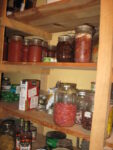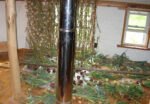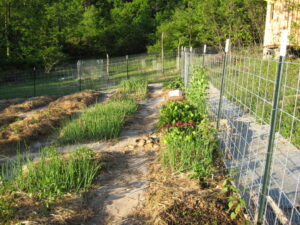A version of this column first ran in the Roane County (WV) Reporter and Times Record as part of a gardening series. Support local journalism! Subscribe to your local newspaper. This is one of a series of blogs for new gardeners. Start reading the whole series here: Part 1.
This week I’m going to make the case for permanent, raised beds in your vegetable garden. You can grow the old-fashioned way, where you till the whole garden every year and then plant everything in rows a couple of feet apart—but then you’re walking quite close to your plants, which compacts the soil. That’s bad for plant roots. And most of your garden is walkways. Whereas, if you make beds somewhere between two and four feet wide, you never walk on the beds, and your walkways can be about eighteen inches wide. You might make some of them wider to accommodate a wheelbarrow, but most can be fairly narrow, so most of the garden space can be occupied by the vegetables.
Another reason for permanent beds is that it makes rotation of crops easier and more effective. The walkways become a barrier to the organisms you don’t want moving from the bed a given crop was in last year, to that crop’s location this year…meaning pest bugs, bacteria, viruses or fungi spores that harm your crops. The distance and the walkways won’t block them, unless your garden is huge or located in a number of separate areas, but this can help.
Now I need to clarify that by “raised beds” I’m not talking about boxes two feet high—those are a good idea if you’re handicapped, have a bad back, or if you have a serious drainage problem. But you need extra soil to build such tall beds, and you have to build the boxes. If you use wood it will likely rot and need repair or replacement in a few years… unless you use pressure-treated wood, which, don’t. At least not for a food garden. That wood leaches toxins, it should not be used for food garden structures or children’s play equipment.
What I have and recommend are beds that are a few inches higher than the walkways. The easy way to construct such beds is to till the ground, and then rake or shovel the topsoil from the walkways into the beds. It’s fine to have walkways of poor subsoil—you don’t want good growth in the walkways. Some people mow walkways, but you can also top them with something impervious. Gravel takes several inches to discourage weeds—if you do use it, get the pea gravel, with small rounded pebbles that are comfortable to walk on. I use Armacell mats, the waterproof grey ones—they give these away or sell them cheap as seconds at their warehouse. They can be slippery when wet, but are marvelous weed blockers. They are especially useful for the perimeter of the garden—the most annoying weeds to eradicate are those that grow under a fence. After pulling the walkways topsoil into the beds, add your amendments—compost, leafmold, manure, sand, wood ashes or lime if your soil is too acidic, any other additives in response to a soil test indicating a deficiency, maybe fertilizer if your soil is poor and you can’t get your hands on slow release materials like compost, manure or leafmold.
Another reason to choose raised beds is that they dry out faster in spring, so are especially useful for the early crops. You can’t easily use a tiller in them, but you can turn them with a shovel, or use one of those little mini-tillers. It’s a good idea to make your garden plan in the fall and prepare the soil then for your earliest spring crops, so you can just peel the hay or leaves or cover crop off the soil, maybe work it up a bit with your hands, and plant. Crops like lettuce and carrots need a well worked, smooth soil; potatoes need a fairly deep loose soil but it can be coarse. Beds that will receive transplants may need only those spots worked up with compost, manure, sand, or whatever they’ll need, with the intervening areas left alone.
A few crops are better in flat ground, not raised beds—I can think of corn and sorghum, tall plants at risk of falling over in a storm. Their roots will anchor better in flat ground. You might keep one corner of your garden for such crops, or a separate patch. You still want to rotate crops, though, so if corn is a major crop for you, you might want to just reserve one corner for raised beds for the early stuff. If you have sandy soil, you also might not like the faster drying of raised beds.
Read the rest: Part 1. Part 2. Part 3. Part 4. Part 5. Part 6. Part 7. Part 8. Part 9. Part 10. Part 11. Part 12. Part 13. Part 14. Part 15. Part 16. Part 17. Part 18. Part 19. Part 20. Part 21. Part 22. Part 23. Part 24. Part 25. Part 26. Part 27. Part 28. Part 29. Part 30. Part 31. Part 32. Part 33. Part 34. Part 35. Part 36. Part 37. Part 38. Part 39. Part 40. Part 41. Part 42. Part 43. Part 44. Part 45. Part 46. Part 47.













